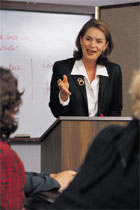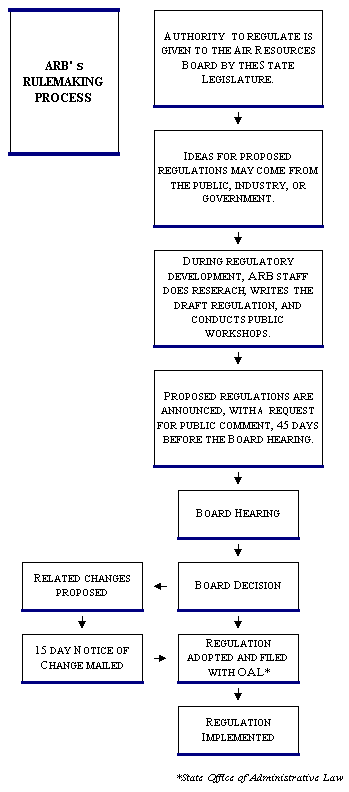Getting Involved in the Rulemaking Process
This page last reviewed April 21, 2010
GET INVOLVED

California Air Resources Board (ARB), the state air quality agency, encourages you to get involved in the air quality regulatory process. Board hearings and workshops are public forums for all points of view. You can present your ideas and hear what others think as well. This pamphlet explains how you can help us find better ways to clean up the air.
Where: The Air Resources Board meets in Sacramento or in other locations around the state as needed.
When: The Board usually meets once a month -- typically on the second Thursday or Friday of the month.
Public hearings are held to decide on regulatory items.
Public meetings are forums for discussion of issues and can include the proposal and approval of reports on air quality and other non-regulatory Board actions.
A public notice, published 45 days before hearings, announces proposed regulatory items and invites public comment.
The agenda for Board meetings is published 10 days before the monthly meeting.
Please consider receiving notices and Board agendas by email or visit our website.
Air Resources Board
Public Information Office
P.O. Box 2815
1001 "I" Street
Sacramento, CA 95812
(916) 322-2990
WHAT HAPPENS AT A
HEARING OR MEETING?
ARB staff presents an item to the Board and then answers questions and discusses the item with the Board members. This is followed by public testimony and discussion. The Board then deliberates and takes action on the item.
Written comments on agenda items may be submitted to the Clerk of the Board. To be considered by the Board, you must mail written comments so that they are received by 12 noon the day before the meeting. Comments can be submitted electronically by going to our Send Us Your Comments webpage and clicking on the appropriate list name. You may also give your written comments directly to the Clerk of the Board at the meeting.
Oral testimony: To testify before the Board on an agenda item, sign up with the Clerk of the Board at the meeting.
When you are called to testify, come to the podium at the front of the Board Room. State your name and affiliation. Present your position clearly and concisely. The Board members and those waiting to testify will appreciate it.
If you have submitted written comments as well, summarize your viewpoint briefly. Board members will have your written comments before them for reference.
If you wish to bring up issues from prior testimony, avoid repeating the same points. Instead, reference the points of interest and focus your testimony on issues not yet covered.
For maximum effectiveness, clear and concise testimony has the greatest impact. When you get right to the point, the Board will respond better to the merits of your presentation.

THE AIR RESOURCES BOARD
The Air Resources Board's eleven members are appointed by the Governor with the consent of the State Senate. They are chosen on the basis of their demonstrated interest and proven ability in the field of air pollution control and their understanding of the needs of the general public in connection with air pollution problems.
Who are the Board Members? Members must meet qualifications specified in the law. Five members must be chosen from the boards of local air quality management districts: one each from the San Diego Air Pollution Control District, San Francisco Bay Area Air Quality Management District, San Joaquin Valley Unified Air Pollution Control District, South Coast Air Quality Management District (greater Los Angeles region), and one from any other district. Three other members fill specific categories. One must have expertise in automotive engineering or a closely related field. One must have expertise in science, agriculture, or law. One must be a physician and surgeon, or health effects expert. One of the three remaining members must have expertise in air pollution control, or must meet the qualifications of one of the three categories mentioned above. The remaining two members are public members. The Governor appoints a full- time Chairperson to the Board from among its members.
WHO REGULATES AIR QUALITY?
FEDERAL
U.S. Environmental Protection Agency- Sets Federal Ambient Air Quality Standards
- Oversees and Approves State Programs
- Provides Technical and Financial Assistance
- Regulates Pollution from Cars and Trucks (Outside California), Trains, Aircraft, and Most Construction and Farm Equipment
STATE
California Environmental Protection Agency
Air Resources Board
- Regulates Mobile Sources (e.g., Cars, Trucks, and Buses), Fuels, Consumer Products, and Air Toxics
- Oversees and Assists Local Districts
- Supports Air Pollution Research
- Sets State Ambient Air Quality Standards to Protect the Public Health
REGIONAL/COUNTY
Air Pollution Control Districts and Air Quality Management Districts
- Governed by Local Elected Officials
- Develop Programs for Local Attainment of Air Quality Standards
- Regulate Stationary Sources via Permits (e.g., Manufacturing Plants, Gas Stations, Refineries)
- Approve Transportation Control Measures
WHY REGULATE AIR QUALITY?
Most Californians breathe polluted air.
The air in California cities, and even some rural areas, is polluted. It threatens our health, property, and environment. With a growing population of over 30 million, and the kind of climate and geography where smog is easily formed, California has a serious air pollution problem.
We rely on government to regulate air pollution.
Government regulations protect the public from unfair or unsafe business practices and individual behavior that cause air pollution. California's health-based air quality standards and strict air pollution regulations have improved air quality in many parts of the state. But air pollution is still a big problem.
Government can't do it alone.
Regulations work best when everyone gets involved. While air pollution experts understand the technical side of air pollution, you know about the problems and special needs of your family, business, or city. You can help air quality regulators create more effective regulations.
WHO TO CALL
(916) 322-2990
CLERK OF THE BOARD
(916) 322-5594
DIVISIONS
MOBILE SOURCE PROGRAM - (626) 575-6858
MONITORING AND LABORATORY - (916) 445-3742
OFFICE OF CLIMATE CHANGE - (916) 322-1853
PLANNING AND TECHNICAL SUPPORT - (916) 322-5350
RESEARCH - (916) 445-0753
STATIONARY SOURCE - (916) 445-0650
AIR RESOURCES BOARD
1001 "I" STREET
P.O. BOX 2815
SACRAMENTO, CA 95812
HAAGEN-SMIT LABORATORY
9480 TELSTAR AVENUE
EL MONTE, CA 91731









